What keeps healthcare executives up at night? It’s not just operational headaches or clinical inefficiencies—it’s the looming threat of a cyberattack. With the average healthcare data breach costing $10.93 million, the stakes are frighteningly high. Yet, traditional cybersecurity models still rely on perimeter defenses that are no match for today’s sophisticated threats.
That’s where zero trust security in healthcare becomes a game-changer. This modern approach rejects blind trust, focusing instead on continuous verification and strict access controls to keep patient data and systems secure.
If you think this sounds like overkill, consider this: medical records are worth up to 50 times more than credit card data on the dark web. Can you really afford to take chances? Dive into this blog to learn how zero trust is reshaping healthcare cybersecurity, not just as a necessity but as a strategic advantage.
Key Takeaways:
- Unmatched Risk Mitigation: By adopting zero trust healthcare frameworks, organizations can address insider threats, secure medical devices, and prevent lateral attacks, ensuring robust patient data protection and operational continuity.
- Integration with Legacy Systems: Zero trust in healthcare can effectively integrate with legacy systems using network segmentation, secure APIs, and hybrid solutions, bridging the gap between outdated infrastructure and modern security needs.
- Cost-Effective Security Evolution: Implementing healthcare zero trust solutions via phased approaches and cloud-based tools reduces upfront costs while delivering long-term savings by minimizing breaches and ensuring compliance.
Table of Contents:
- A Cybersecurity Crisis in Healthcare
- What Is Zero Trust Architecture?
- Benefits of Zero Trust for Healthcare Organizations
- Key Components of a Zero Trust Healthcare Model
- Implementation Strategies for Healthcare Organizations
- Compliance Mapping: Aligning ZTA with HIPAA and TEFCA
- Zero Trust and the Security of Medical Devices
- Overcoming Barriers to Zero Trust Adoption
- Future Outlook: Zero Trust and Evolving Cyber Threats in Healthcare
- The Time for Zero Trust Is Now
A Cybersecurity Crisis in Healthcare
Healthcare organizations are prime targets for cyberattacks, with sensitive patient data being a goldmine for hackers. Unlike financial data, medical records are immutable, carrying immense value on the dark web. As a result, the healthcare industry faces the highest average data breach cost—$10.93 million, according to the Ponemon Institute.

This isn’t just about financial penalties. Cyberattacks can disrupt clinical operations, compromise patient safety, and tarnish organizational credibility. Emergency rooms unable to access medical data, delayed surgeries, and medication errors during system outages are real consequences healthcare providers face. Protecting healthcare data has never been more critical.
Several factors amplify vulnerabilities in healthcare cybersecurity:
- Legacy systems: Outdated technology lacking modern information security measures.
- IoT device adoption: The growing use of connected devices expands the attack surface.
- Complex infrastructure: Healthcare networks require seamless access to patient data, creating potential gaps in compliance and protection.
Add to this the rising need for data privacy with ChatGPT in healthcare and other AI tools, and the challenge becomes even more daunting.
Enter the healthcare cyber security zero trust model, a modern framework based on the principle of “Never trust, always verify.” Unlike traditional perimeter-based defenses, Zero Trust continuously monitors and verifies access to ensure that patient info and medical data remain secure.
This approach directly addresses information security gaps, bolstering compliance and safeguarding both infrastructure and patient safety.
What Is Zero Trust Architecture?
Zero Trust Architecture (ZTA) is more than just a buzzword in cybersecurity—it’s a paradigm shift designed to address modern threats by replacing outdated perimeter-based security models. At its core, ZTA operates on a simple principle: “Never trust, always verify.”
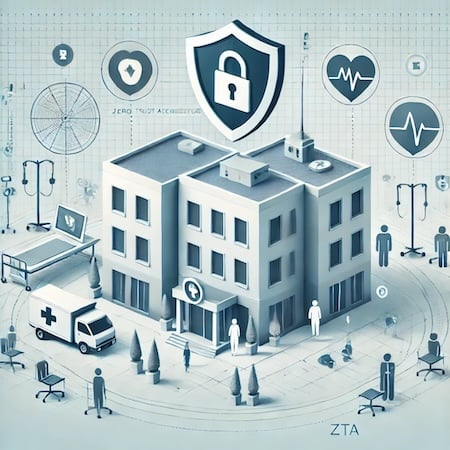
This means no user, device, or application is automatically trusted, whether inside or outside the network. Instead, access is granted based on strict identity verification, real-time context, and continuous monitoring. This ensures that every access attempt aligns with the security system’s trust value and trust degree criteria, providing an additional layer of scrutiny.
The Core Principles of Zero Trust
At the heart of Zero Trust Architecture lies a set of guiding principles that reshape traditional approaches to security. These principles ensure that organizations can stay resilient against increasingly sophisticated cyber threats while maintaining operational efficiency.
- Never Trust, Always Verify: Every access request must be validated against predefined rules, regardless of where it originates.
- Least Privilege Access: Users and devices are granted the minimum level of access necessary to perform their tasks.
- Micro-Segmentation: The network is divided into smaller, isolated zones to contain potential breaches.
- Continuous Monitoring and Analytics: Threats are detected and mitigated in real time, ensuring constant vigilance.
These principles not only form the backbone of a Zero Trust cybersecurity framework but also align seamlessly with healthcare’s need for protecting patient data and ensuring compliance.
Why Healthcare Needs Zero Trust
The healthcare zero trust cybersecurity framework is particularly vital for the industry due to its unique challenges:
- Sensitive Patient Data: Healthcare providers manage vast amounts of health information, including medical histories, prescriptions, and lab results. These datasets are prime targets for cybercriminals.
- Regulatory Compliance: Strict regulations like HIPAA demand robust information security measures to protect patient data and ensure compliance.
- Complex Ecosystem: From IoT devices in hospital rooms to cloud-based EMRs, healthcare infrastructure involves diverse, interconnected systems that amplify vulnerabilities.
The Automation Advantage
Automation in healthcare administration plays a pivotal role in implementing Zero Trust Architecture. Leveraging AI and machine learning enables organizations to detect unusual access patterns or behavioral risks in real-time, streamlining access control processes to reduce human error.
This approach not only enhances information security but also ensures scalability for managing complex healthcare networks effectively.
Real-World Impact of ZTA
Adopting a Zero Trust model isn’t just about mitigating risks; it’s about empowering healthcare organizations to:
- Safeguard patient safety by protecting medical devices and health data.
- Build resilience against evolving cyber threats.
- Maintain operational continuity while meeting compliance requirements.
In the context of healthcare, Zero Trust isn’t a luxury—it’s a necessity for ensuring both security and trust in an increasingly digital world.
Benefits of Zero Trust for Healthcare Organizations
Adopting a Zero Trust model provides significant advantages for healthcare organizations:
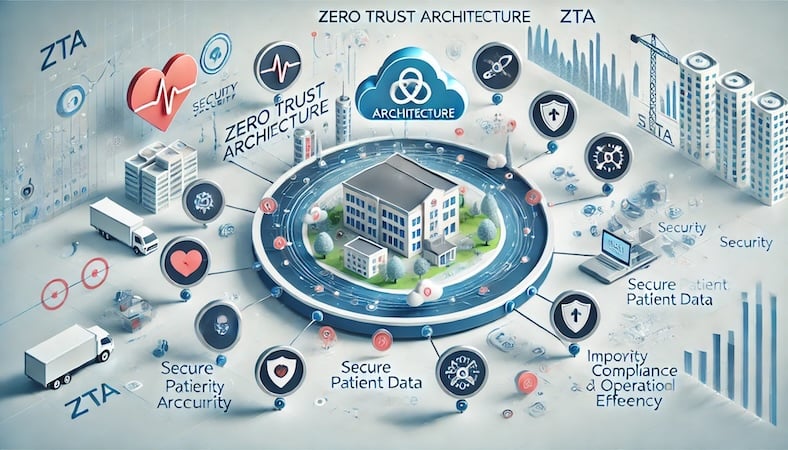
- Enhanced Patient Data Protection: Zero Trust for healthcare enforces stringent access controls, continuous monitoring, and data encryption (in transit and at rest) to safeguard sensitive patient information, reducing data breach risks.
- Mitigation of Insider and External Threats: Privileged access is minimized and dynamically managed, ensuring only essential access is granted. Behavioral analysis tools detect and prevent unauthorized access attempts in real time, improving access management and reducing vulnerability levels.
- Streamlined Compliance: By embedding data protection measures into workflows, Zero Trust simplifies HIPAA compliance application development and aligns organizational processes with regulatory standards.
- Scalability for Cloud Solutions: Network segmentation and dynamic access controls enable secure collaboration across cloud platforms, supporting modern healthcare operations without compromising security.
With these solutions, Zero Trust implementation in healthcare organizations addresses key challenges while building a resilient cybersecurity foundation.
Key Components of a Zero Trust Healthcare Model
Implementing a Zero Trust model in healthcare demands an integrated approach to address the sector’s unique challenges. By relying on foundational components, organizations can secure patient data and comply with stringent regulations effectively.

Dynamic Access Controls
Dynamic access control ensures access to sensitive data or systems is granted only when explicitly required. This involves real-time identity verification and contextual analysis, such as device type and user behavior.
For example, a clinician accessing EMR data from an unrecognized device might trigger additional security measures, safeguarding critical systems from unauthorized access.
Encryption
Encryption ensures that patient and operational data remain secure in transit and at rest. A robust encryption policy helps mitigate exposure during data breaches, protecting providers from regulatory penalties and reputational damage. Cloud security solutions amplify this protection.
Network Segmentation
Network segmentation isolates healthcare networks into zones, limiting lateral movement after a breach. For instance, a compromised medical device would be contained, preventing access to critical patient records. This granular control model is vital for securing IoT devices and web3 healthcare software development applications.
AI-Driven Risk Analysis
AI identifies threats by analyzing user behavior and detecting anomalies. AI-powered tools flag suspicious activities like unauthorized access attempts, significantly reducing behavioral risks and unauthorized access incidents.
Implementation Strategies for Healthcare Organizations Adopting Zero Trust
Adopting Zero Trust Security Healthcare principles can seem daunting, especially when navigating legacy systems, training staff, and integrating cutting-edge tools like AI and cloud technologies. However, a phased and methodical approach ensures a smoother transition and maximizes the benefits of this robust framework.
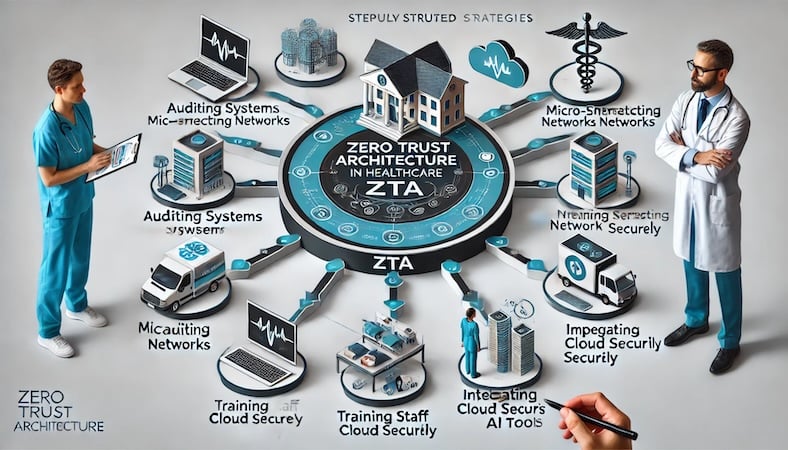
Below is a summary table outlining the key steps for successful implementation of ZTA in healthcare:
| Step | Action | Key Highlights |
| 1. Assess Readiness | Audit existing systems, evaluate legacy compatibility, and analyze user behavior risks. | Identify critical assets, prioritize micro-segmentation for outdated devices, and establish a baseline for access controls. |
| 2. Establish Core Principles | Define least privilege access and dynamic access controls. | Tailor access rules to roles and tasks while using AI to adapt permissions based on context. Avoid over-restricting access. |
| 3. Integrate Cloud Securely | Encrypt data, secure API gateways, and implement continuous monitoring. | Safeguard EMRs, limit API access with real-time identity verification, and use AI for traffic anomaly detection. |
| 4. Build a Training Program | Educate staff, simulate threats, and encourage a cybersecurity-focused culture. | Provide actionable training, run phishing simulations, and involve all teams to share accountability. |
| 5. Implement AI-Driven Tools | Use AI for behavior analytics, incident response, and dynamic risk assessment. | Detect anomalies, automate threat containment, and dynamically adjust access permissions. |
| 6. Manage Change Effectively | Engage stakeholders, pilot programs, and establish feedback loops. | Test in specific departments, address resistance early, and refine based on team feedback. |
Step 1: Assess Readiness for Zero Trust
Before diving into implementation, healthcare organizations must assess their current cybersecurity posture:
- Audit Existing Systems: Identify critical assets, sensitive data, and vulnerable points within the infrastructure.
- Evaluate Legacy Compatibility: Legacy systems are prevalent in healthcare. Determine which systems can be upgraded or require isolation using network segmentation.
- Analyze User Behavior Risk: Leverage tools that map user behavior to pinpoint abnormal patterns, providing a baseline for implementing dynamic access controls.
For instance, hospitals with outdated medical devices should prioritize micro-segmentation to isolate these from sensitive networks, preventing lateral threats.
Step 2: Establish Core Zero Trust Principles
Zero Trust is not a one-size-fits-all model. Start with foundational principles tailored to healthcare:
- Least Privilege Access: Grant minimal access based on roles and tasks. For example, restrict billing staff to financial systems without touching patient EMRs.
- Dynamic Access Controls: Employ AI to adapt permissions dynamically, verifying access requests against parameters like location, device type, and behavior.
One common pitfall is over-restricting access, which can frustrate staff and disrupt workflows. To avoid this, it’s essential to conduct thorough role-based access mapping, ensuring that permissions align with the actual tasks employees need to perform.
Step 3: Integrate Cloud Technologies Securely
With the healthcare sector increasingly reliant on healthcare mobile app development and cloud platforms, ensuring robust cloud integration is critical:
Encryption at Rest and in Transit
Safeguard patient data stored in cloud-based EMRs or transmitted through mobile apps.
Secure API Gateways
Limit access to APIs connecting mobile apps, IoT medical devices, and cloud systems using real-time identity verification.
Continuous Monitoring
Use AI to analyze traffic patterns for anomalies, enhancing security for both cloud and on-premise systems.
Step 4: Build a Comprehensive Training Program
Healthcare cybersecurity is only as strong as its weakest link—often, human error. Training programs must:
- Educate Staff on Zero Trust Basics: Break down complex concepts into actionable steps for clinicians, administrative staff, and IT teams.
- Simulate Threat Scenarios: Run phishing simulations and insider threat drills to reinforce awareness.
- Encourage Culture Change: Promote understanding that cybersecurity is a shared responsibility across the organization.
Step 5: Implement Advanced AI-Driven Tools
Artificial intelligence can supercharge Zero Trust strategies:
- User Behavior Analytics (UBA): Detect abnormal behavior, like a clinician downloading unusually large volumes of patient data.
- Automated Incident Response: AI tools can contain threats in real-time, such as locking down a compromised IoT device.
- Dynamic Risk Assessment: Dynamic risk assessment powered by AI is a cornerstone of zero trust architecture in healthcare. AI continuously evaluates contextual factors like device security posture, user location, and access history. Access permissions are granted or denied dynamically, aligning with Zero Trust principles.
By employing AI-driven tools, healthcare organizations can reduce reliance on manual monitoring, which is prone to human error and inefficiencies.
Step 6: Manage Change Effectively
Adopting Zero Trust Security Healthcare principles often involves significant operational changes.
Engage Stakeholders Early
Involve clinicians, IT teams, and administrators in discussions to identify potential friction points.
Pilot Programs
Test Zero Trust principles in specific departments (e.g., radiology) before scaling organization-wide.
Feedback Loops
Regularly review implementation progress and adjust strategies based on staff input and performance metrics.
Compliance Mapping: Aligning ZTA with HIPAA and TEFCA
As healthcare regulations evolve, ensuring compliance is a critical driver for adopting advanced cybersecurity frameworks like Zero Trust Architecture (ZTA). Both the Health Insurance Portability and Accountability Act (HIPAA) and the emerging Trusted Exchange Framework and Common Agreement (TEFCA) emphasize robust data protection, making ZTA a natural fit for healthcare organizations aiming to meet and exceed these standards.
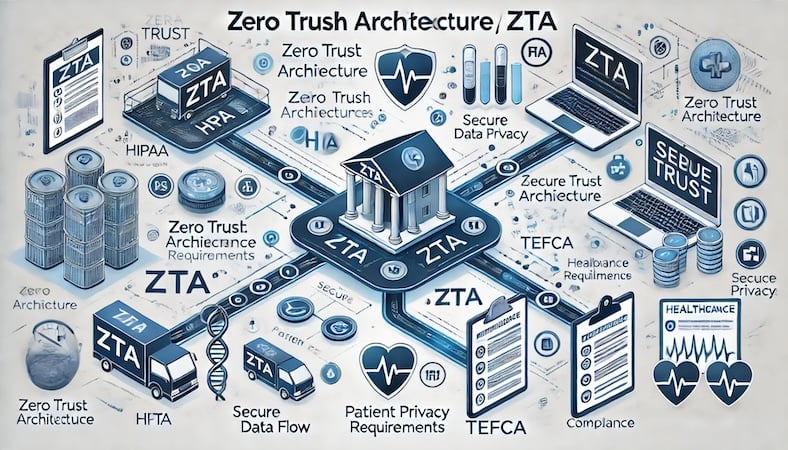
HIPAA Compliance with ZTA
HIPAA outlines strict requirements for safeguarding Protected Health Information (PHI) under its Security Rule, which is divided into three main categories. Here’s how ZTA aligns with these requirements:
1. Administrative Safeguards
HIPAA Requirement: Implement a security management process to reduce risks and vulnerabilities.
ZTA Alignment:
- Continuous monitoring tools analyze and mitigate risks in real-time.
- AI-driven behavior analytics detect anomalies, such as unusual data access patterns, aligning with risk management policies.
HIPAA Requirement: Ensure workforce members have appropriate access to PHI.
ZTA Alignment:
- Least privilege access ensures users are granted only the minimum permissions necessary to perform their tasks.
- Role-based access control dynamically adjusts permissions based on user roles and real-time context.
2. Physical Safeguards
HIPAA Requirement: Limit physical access to systems storing PHI while ensuring authorized access is available.
ZTA Alignment:
- Multi-factor authentication (MFA) restricts access to on-premises servers and IoT medical devices.
- Network segmentation isolates devices and systems, reducing risks of unauthorized physical access.
3. Technical Safeguards
HIPAA Requirement: Implement access control mechanisms to restrict access to PHI.
ZTA Alignment:
- Dynamic access controls verify user identity, device health, and context before granting access to PHI.
- Micro-segmentation limits lateral movement within networks, protecting sensitive data even during an attack.
HIPAA Requirement: Encrypt PHI during transmission and at rest.
ZTA Alignment:
- End-to-end encryption, coupled with secure API gateways, ensures data protection across cloud platforms, EMRs, and mobile apps.
TEFCA Compliance with ZTA
TEFCA, a framework designed to promote nationwide interoperability for health information exchange (HIE), introduces additional challenges for data security and privacy. ZTA provides an ideal framework to meet these requirements:
1. Privacy and Security Framework
TEFCA Requirement: Ensure all participants adopt rigorous security measures to safeguard exchanged data.
ZTA Alignment:
- Conditional access policies validate trust for every exchange, ensuring compliance with strict data-sharing rules.
- Real-time monitoring mitigates unauthorized access to sensitive health data during exchanges.
2. Identity Verification and Authentication
TEFCA Requirement: Establish standardized methods for verifying the identity of entities and individuals accessing HIEs.
ZTA Alignment:
- Identity and Access Management (IAM) systems integrate with ZTA to authenticate users based on location, device, and behavior.
- MFA ensures a secure handshake before data exchange occurs.
3. Auditing and Reporting
TEFCA Requirement: Maintain detailed logs of access and transactions for auditing purposes.
ZTA Alignment:
- ZTA’s continuous monitoring capabilities generate granular logs for all access attempts, enabling traceability and compliance with TEFCA’s auditing standards.
Organizations adopting ZTA can confidently safeguard sensitive data while navigating the complexities of HIPAA and TEFCA compliance, ensuring trust among patients, regulators, and partners.
Zero Trust and the Security of Medical Devices
As Zero Trust Architecture (ZTA) reshapes healthcare cybersecurity, its implications for connected medical devices cannot be overlooked. These devices, integral to patient care, operate in an environment fraught with vulnerabilities, making them prime targets for cyberattacks.
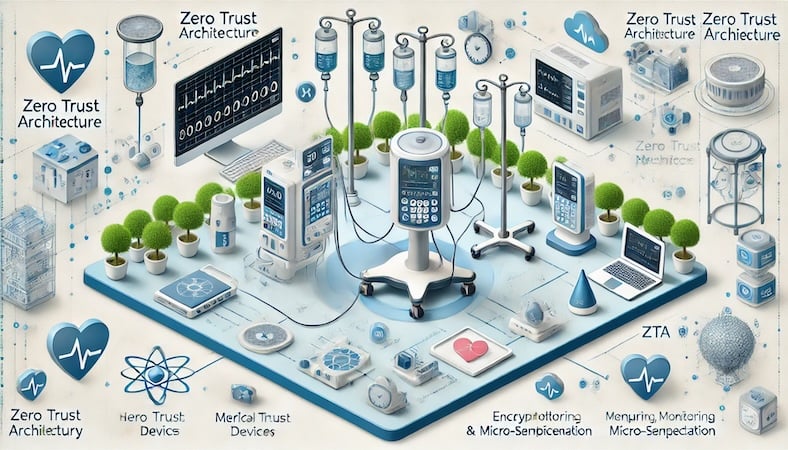
Ensuring their security is not just about compliance but about safeguarding patient lives and the integrity of clinical operations. By extending healthcare zero-trust security principles to medical devices, organizations can address these unique challenges head-on.
The Vulnerabilities of Connected Medical Devices
The rapid adoption of IoT in healthcare has introduced a new frontier of risks. Unlike traditional IT systems, medical devices often have:
- Outdated Software: Many devices rely on legacy operating systems that lack modern security patches.
- Limited Encryption: Sensitive data transmitted between devices and networks is often insufficiently encrypted, exposing it to unauthorized access.
- Broad Access Privileges: Devices frequently operate with more access than necessary, increasing the risk of misuse or compromise.
Applying Zero Trust Principles to Medical Devices
A Zero Trust approach offers a robust framework to secure medical devices and their associated ecosystems:
- Dynamic Access Controls: Every device’s access request is verified in real-time, ensuring only authorized users and systems can interact with the device.
- Micro-Segmentation: Networks are divided into isolated zones, limiting a potential breach’s impact on other devices or systems.
- Continuous Monitoring: Behavior risk analytics identify unusual activity patterns, such as unauthorized data requests or anomalous device behavior.
Real-World Examples of Medical Device Security Breaches
The vulnerabilities are not hypothetical. In 2017, the WannaCry ransomware attack disrupted medical devices globally, including radiology equipment from Siemens, forcing hospitals like the UK’s National Health Service (NHS) to cancel appointments and surgeries.
In another incident, security researchers uncovered vulnerabilities in Medtronic pacemakers that allowed hackers to gain control over device settings remotely, putting patients at risk. These real-world examples underscore the urgent need for robust healthcare zero trust security measures.
By applying Zero Trust principles to medical device software development, healthcare providers can ensure that encryption, access controls, and continuous monitoring are at the forefront of protecting sensitive data and patient safety in the healthcare industry.
Overcoming Barriers to Zero Trust Adoption
Adopting zero trust architecture healthcare solutions is critical for protecting patient data and ensuring HIPAA compliant software development, yet misconceptions, costs, and resistance often hinder progress. Here’s how to address these challenges.
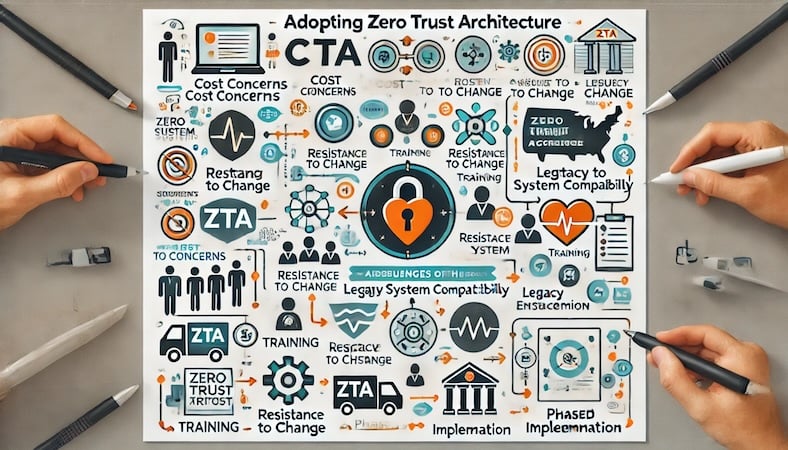
Misconceptions: Is Zero Trust Overkill?
Many healthcare leaders view zero trust as overly complex or unnecessary. However, traditional perimeter-based models fall short against today’s threats. By emphasizing risk value and how zero trust uses vulnerability level assignment for every access attempt, organizations can balance security with seamless workflows.
Cost Concerns: Can We Afford It?
Budget constraints can make zero trust adoption seem daunting, but strategic implementation makes it manageable:
- Start small: Focus on high-risk areas, like EMRs and IoT devices, for immediate impact.
- Leverage cloud solutions: Use scalable platforms to reduce infrastructure costs.
- Emphasize ROI: Highlight savings from fewer breaches and compliance penalties.
Resistance to Change
Healthcare teams often resist security upgrades out of workflow disruption fears. Engage leadership early to align zero trust goals with broader objectives like patient safety. Tailored training programs can help staff understand how dynamic controls protect data without hindering operations. Pilot projects in low-risk areas can demonstrate success and build trust across teams.
Legacy System Compatibility
Outdated infrastructure presents challenges, but smart strategies can bridge the gap:
- Network segmentation: Isolate legacy systems to minimize lateral threats.
- Secure APIs: Connect older systems to modern zero trust tools through API gateways with strict authentication.
- Hybrid models: Blend on-premise and cloud-based zero trust solutions to support legacy systems while advancing cybersecurity.
Building a Culture of Security
Zero trust relies on shared accountability. Engage teams with ongoing feedback channels, fostering a culture where cybersecurity becomes everyone’s responsibility.
Future Outlook: Zero Trust and Evolving Cyber Threats in Healthcare
The future of zero trust in healthcare is shaped by evolving cyber threats and advancements in technology. AI will enhance real-time threat detection and automate responses to unauthorized access, while dynamic security protection will adapt to changing risks.
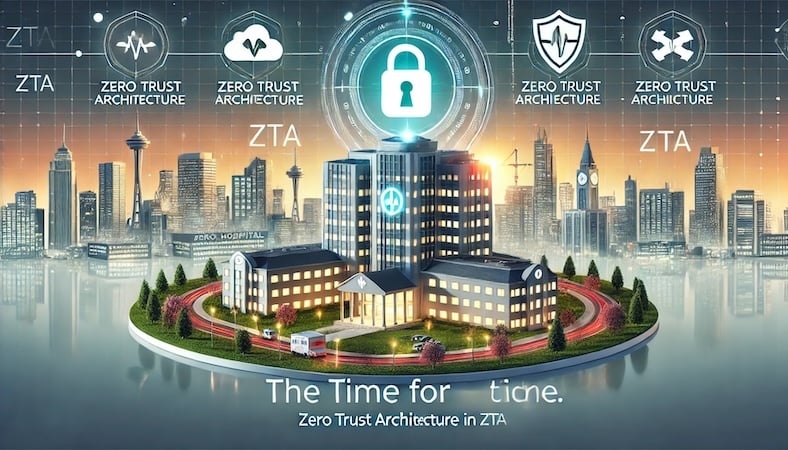
Policies enforcing strict authentication and encrypted communication will secure connected medical equipment, reducing vulnerabilities.
Continuous improvement will be vital as compliance demands, like HIPAA updates, grow. Zero trust’s adaptability ensures policies evolve seamlessly with regulatory shifts.
Emerging technologies like 5G and edge computing will integrate zero trust principles from the start, securing innovations like cloud-based EHRs and remote monitoring devices.
Insider threats remain a concern, but zero trust mitigates these risks with behavior monitoring and dynamic access controls.
The Time for Zero Trust Is Now
Organizations that prioritize zero trust are taking meaningful steps toward securing sensitive healthcare information while bolstering compliance. From dynamic access controls to security protection tailored for connected devices, the zero trust framework delivers unmatched resilience. By addressing insider threats, reducing attack surfaces, and integrating with emerging technologies like AI and cloud platforms, zero trust isn’t just a strategy—it’s a necessity.
At Topflight, we understand the challenges healthcare organizations face in transitioning to zero trust. While every organization’s journey will differ, the principles remain universal: “Never trust, always verify.” By embedding zero trust security in healthcare, organizations can safeguard their operations and patient data, building a future-ready foundation for cybersecurity. There’s no better time to act than now.
Frequently Asked Questions
What is the role of AI in zero trust for healthcare?
AI enables real-time threat detection, dynamic access controls, and anomaly identification, enhancing the effectiveness and automation of Zero Trust frameworks in protecting sensitive healthcare data and systems.
Can zero trust be implemented in legacy healthcare systems?
Yes, Zero Trust can integrate with legacy systems through network segmentation, secure API gateways, and hybrid solutions, isolating vulnerabilities while ensuring operational continuity.
How does zero trust address insider threats in healthcare?
Zero Trust limits access based on roles, monitors user behavior, and uses real-time risk analysis to detect and mitigate unauthorized activities, reducing insider threat risks.
Is zero trust compatible with cloud-based healthcare platforms?
Absolutely. Zero Trust secures cloud-based systems with encryption, dynamic access controls, and continuous monitoring, ensuring compliance and robust data protection.
What are the cost implications of implementing zero trust in healthcare?
While initial costs vary, phased implementation and scalable solutions, like cloud-based tools, reduce expenses over time, offering significant savings by preventing breaches and compliance penalties.